Moraea miniata
Moraea miniata Andrews
Family: Iridaceae
Common names: two-leaf Cape tulip, red Cape tulip, poison bulb (Eng.), pronktulp, rooitulp, geeltulp, kraaitulp (Afr.)
Introduction
A stunning plant with delicate petals that flowers in masses during late winter and spring, turning patches of the veld bright salmon pink. A member of the Moraea genus in the iris family, Moraea miniata is the ultimate botanical treasure waiting to be discovered by intrepid explorers and plant enthusiasts alike.
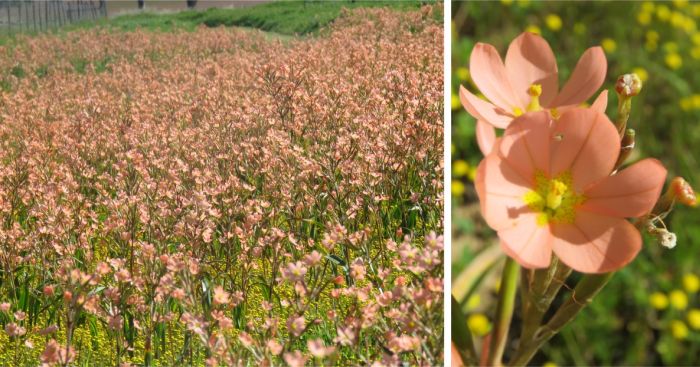
Description
Description
Moraea miniata is a deciduous, cormous, herbaceous perennial 150-600 mm tall that has a green upright stem, sometimes slightly zigzagging and 2-3 long thin, trailing leaves. It produces salmon pink (pinkish orange), sometimes yellow or white flowers, with relatively broad petals that grow up to 13-25 mm long, in late winter and spring (August to October). The fruit is an elongated capsule. It produces small cormels in the axils at the base of the underground corms, and sometimes also at the base of the dying flowers.
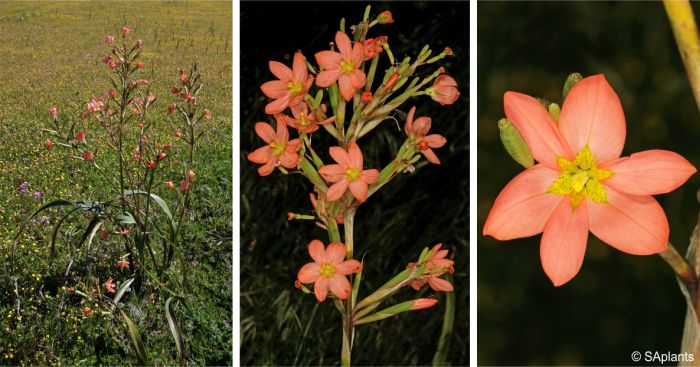
Conservation Status
Status
Moraea miniata is assessed as Least Concern (LC) by the Red List of South African plants, it is widespread and common and not in danger of extinction.
In Australia where it was introduced as a garden ornamental and has become naturalised, Moraea miniata has been declared a noxious weed under the Agriculture and Related Resources Protection Act 1976 in the Plants Listing for Western Australia and an environmental weed in the Environmental Weed List Victoria. In the USA it is listed as noxious by the United States Department of Agriculture Natural Resources Conservation Service. CABI flags Moraea miniata as a plant that has proven to be invasive outside of its native range where it can negatively impact agriculture, human health, animal health, livelihoods and be a threat to native species.
Distribution and habitat
Distribution description
Moraea miniata is native to southern Africa where it is widely spread in Western Cape and Northen Cape, growing mainly on clay slopes, in Renosterveld, Fynbos, Nama Karoo and Succulent Karoo, from Namaqualand to Riversdale. The climate is semi-arid with a cool, rainy winter and a hot, dry summer.
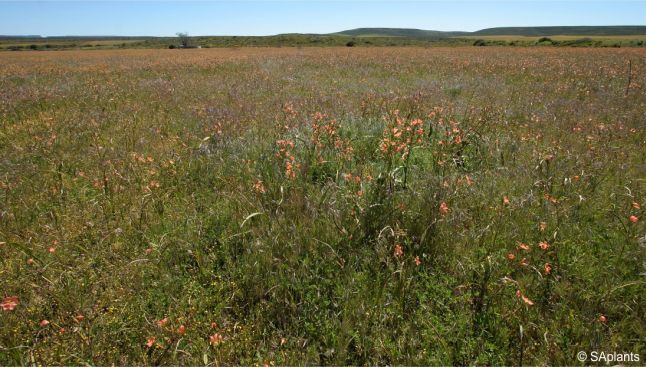
Derivation of name and historical aspects
History
The genus Moraea was first named Morea by Phillip Miller in 1758, after the English botanist Robert More of Shropshire. Then Linnaeus changed the spelling to Moraea. Linnaeus married Sara Elisabeth Moraea; her father was Dr. Johan Moraeus, the town physician of Falun. The specific epithet miniata means ‘the colour of red lead’, referring to the flowers. Red lead oxide, also known as minium, is a bright orange-red pigment widely used for painting and decorating manuscripts during the Middle Ages (500-1500 CE).

Ecology
Ecology
At Hantam National Botanical Garden, Moraea miniata flowers are regularly seen to be visited by long-tongued bees foraging for the nectar and pollen. The bees are attracted to the smell and colour of the flower. Cross pollination is observed as the bees move from one flower to another. Other pollinators seen on the flowers are sunbirds, butterflies, ants and beetles.
The leaves, both fresh and dried, are poisonous to grazing animals.
Moraea miniata survives the hot dry summer by dying back in early summer and lying dormant underground until the rains return in autumn, when they resprout and grow.
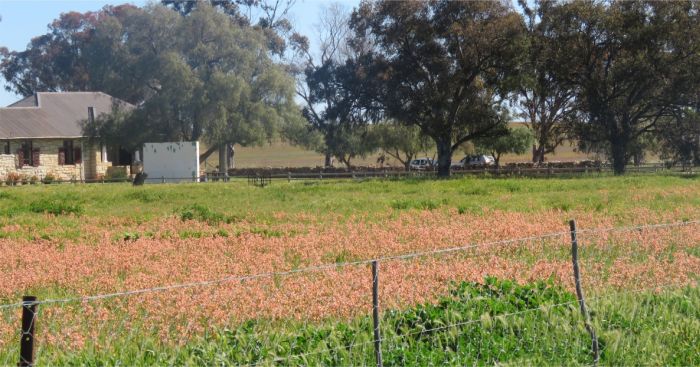
Uses
Use
Moraea miniata has high horticultural value because it makes a good potted plant and when mass planted, its beautiful orange-pink flowers make it an ornamental favourite in landscapes.
There is no information that shows any medicinal or cultural uses of Moraea miniata, however all parts of this plant are poisonous when eaten and they are toxic to livestock. The closely related species Moraea collina, Moraea pallida, Morea polystachya, Moraea elegans, Moraea flaccida and Moraea ochroleuca are also toxic to grazing animals.
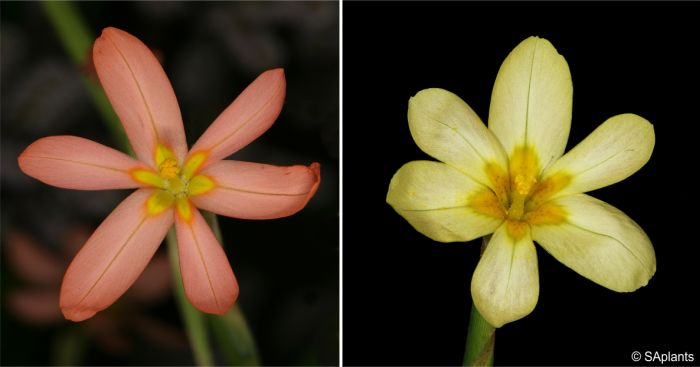
Growing Moraea miniata
Grow
Moraea miniata is not cultivated widely but can be propagated by seeds or cormels.
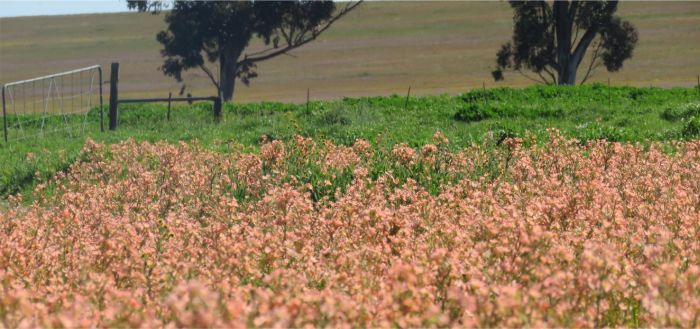
At Hantam NBG, the seeds were sprinkled in a sunny, well-drained flower bed in autumn and left to germinate with the rain and grow naturally.They are given little attention and the plants have rewarded the garden with lots of flowers. Seeds can be sown in deep seed trays filled with well-drained sowing medium, sown 3-4 mm deep and kept moist. Seeds should germinate in 4-6 weeks, and the seedlings should be left undisturbed for two growing seasons before lifting and transplanting.
Moraea miniata primarily reproduces through cormels (tiny corms) rather than seeds. These cormels form around the base of the plant and in the angle of each leaf. Separate these cormels from the mother plant and replant in autumn, just before active growth begins.
Moraea miniata grows from corms. These corms are bulb-like structures located below the ground. Corms are best lifted and replanted while they are dormant. When planting, space the corms, 10-15 cm apart. Place the corms with the pointed end facing up. Apply a layer of organic mulch around the planted corms to retain moisture and suppress weeds. Water the newly planted corms moderately to establish root systems and avoid overwatering. Ensure the soil is well-drained to prevent waterlogged conditions. Regularly remove weeds around the planted area to prevent competition. Apply a balanced, low-nitrogen fertilizer during the growing season. Remove faded flowers to encourage continuous blooming. Always keep in mind that Moraea miniata corms can remain dormant in the soil for several years.
Moraea miniata can be planted either in summer or winter growing climates, for summer plant them in spring and in winter plant them in autumn. It is not hardy in cold climates.
References
- Aubrey, A. 2001. Clivia miniata (Lindl.) Regel (Amaryllidacee). PlantZAfrica. Online. http://pza.sanbi.org/clivia-miniata.
- Bakewell-Stone, P. 2024. Invasive Species Datasheet: Moraea miniata (two-leaf Cape tulip). CABI Compendium. Online. https://www.cabidigitallibrary.org/doi/full/10.1079/cabicompendium.110456.
- Botha, C.J., & Venter, E. 2002. Moraea species. University of Pretoria Faculty of Veterinary Science, Dept. of Paraclinical Sciences – Pharmacology & Toxicology. https://repository.up.ac.za/handle/2263/8500.
- Duncan, G. 2009. Moraea tulbaghensis L.Bolus (Iridaceae). PlantZAfrica. Online. http://pza.sanbi.org/moraea-tulbaghensis.
- Goldblatt, P. & Manning, J. 2000. Cape Plants. A conspectus of the Cape flora of South Africa. Strelitzia 9. National Botanical Institute, Pretoria & Missouri Botanical Garden, Missouri.
- Goldblatt, P. 1981. Systematics and biology of Homeria (Iridaceae). Annals of the Missouri Botanical Garden 68(3):413-503.
- Goldblatt, P., Naidoo, K. & Turner, R.C. 2006. Moraea miniata Andrews. National Assessment: Red List of South African Plants. Accessed on 2024/07/19.
- Pacific Bulb Society. Homeria Two. https://www.pacificbulbsociety.org/pbswiki/index.php/HomeriaTwo#miniatahttps://doi.org/10.2307/2398777. Accessed on 2024/07/19.
- SAplants. Photographs of Moraea miniata. Released under CC BY-SA 4.0 licence. https://commons.wikimedia.org/wiki/Category:Photographs_by_SAplants. Accessed 2 Aug 2024.
- Weeds of Australia. Moraea miniata Andrews. https://keyserver.lucidcentral.org/weeds/data/media/Html/moraea_miniata.htm. Accessed on 2024/07/19.
- Wikipedia. Minium (pigment). https://en.wikipedia.org/wiki/Minium_(pigment). Accessed 2 Aug 2024.
Credits
Nokuthula Michelle Siwelane
Hantam National Botanical Garden
August 2024
Acknowledgements: additional images by SAplants.
Plant Attributes:
Plant Type: Bulb
SA Distribution: Northern Cape, Western Cape
Soil type: Sandy, Clay, Loam
Flowering season: Spring, Winter
PH: Acid, Neutral
Flower colour: Pink, Yellow, Orange
Aspect: Full Sun
Gardening skill: Easy
Special Features:
Horticultural zones








Rate this article
Article well written and informative
Rate this plant
Is this an interesting plant?
Login to add your Comment
Back to topNot registered yet? Click here to register.